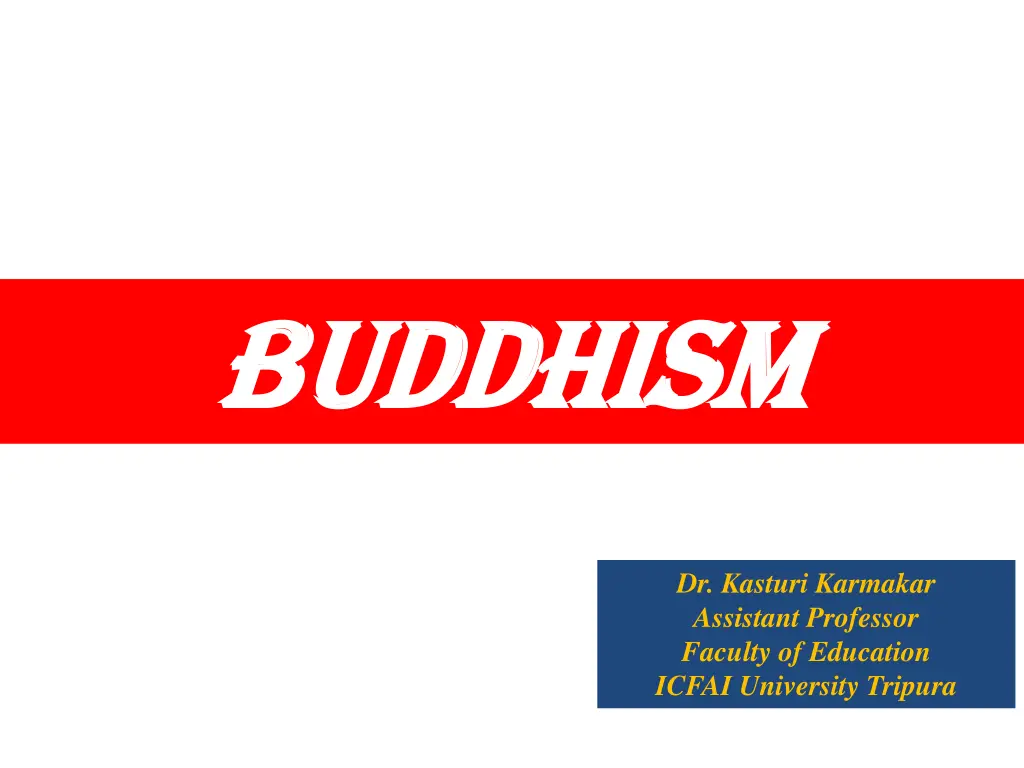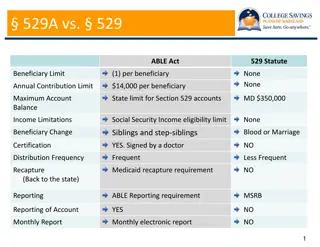
Key Aspects of Buddhism: Principles, Classification, and Educational Philosophy
Discover the fundamental principles of Buddhism, including the Doctrine of Non-Self, Nirvana, the Four Noble Truths, and the Eightfold Path. Explore the classification of Buddhism into Hinayana and Mahayana schools, and learn about Buddhist educational philosophy that led to the establishment of renowned educational centers in ancient India.
Download Presentation

Please find below an Image/Link to download the presentation.
The content on the website is provided AS IS for your information and personal use only. It may not be sold, licensed, or shared on other websites without obtaining consent from the author. If you encounter any issues during the download, it is possible that the publisher has removed the file from their server.
You are allowed to download the files provided on this website for personal or commercial use, subject to the condition that they are used lawfully. All files are the property of their respective owners.
The content on the website is provided AS IS for your information and personal use only. It may not be sold, licensed, or shared on other websites without obtaining consent from the author.
E N D
Presentation Transcript
Buddhism Buddhism Dr. Kasturi Karmakar Assistant Professor Faculty of Education ICFAI University Tripura
Principles of Buddhism The most striking feature of Buddhism is the Doctrine of Non-Self (Anatta). Buddhism advances the theory of Nirvana. Nirvana is a state total freedom and no sufferings, with perfect knowledge, perfect peace and perfect wisdom, man is free from all bondage in the state of Nirvana. Lord Buddha taught his followers four NobleTruths or Aryasatya .
Principles of Buddhism The four noble truths presented by Buddha are (i) The Truth of suffering (Dukkha). (ii)The truth of the origin of suffering (Samudaya). (iii) The truth of the cessation of suffering (Nirodha). (iv)The truth of the path to the cessation of suffering (Marga).
Principles of Buddhism The eight fold path to Nirvana suggested by the Buddha are Right to Belief Right to Memory Right to Speech Right to Thought Right to Meditate Right to Effort Right to Conduct Right to Action
Classification of Buddhism School Hinayana School (Lesser Vehicle) 1. Its followers believed in the original teaching of Buddha. 2. They sought individual salvation through self- discipline and meditation. 3. They did not believe in idol worship. 4. They favour Pali language. 5. It is known as Southern Buddhist Religion because it prevailed in South India. (Sri Lanka, Burma etc.) 6. There wee two sub-sects of Hinayana i.e. Vaibhasika and Sautrantika
Classification of Buddhism School Mahayana School (Greater Vehile) 1. It followers believed in the heavenliness of Buddha. 2. They sought the salvation of all through the grace and help of Buddha and Bodhisattva. 3. They believe in idol worship. 4. They favoured Sanskrit language. 5. It is known as Northern Buddhist Religion because it prevailed in North India and religions like China, Korea, Japan etc.
Educational Philosophy Buddhist education offered to impart education for all. Many people shifted to Buddhist educational system. It was for the first time in India that education was institutionalized on a large scale during Buddhist movement. It is also a historic fact that with the arrival of Buddhist era, great international centre of education like Nalanda, Takshashila, Vikramshila, Ballabhi, Odantapuri, Nadia, Amravati, Nagahalla and Sarnath were in prominence. Educational centre in Buddha period developed in Viharas and Sanghas.
Aims of Education To follow the moral values of Buddhist religion. To eradicate Vedic Karmakanda or Ritualism. To provide education in the language of masses i.e. Pali. To give up caste system. To achieve the final goal of Nirvana. To emphasize the progress and development of the society rather than the individual. To provide education through the new system and this was stated by Buddha.
Methods of Teaching Methods of Teaching Agra Shishya Pranali (Monitorial System) Mostly Verbal with Discussions and Debates Preaching and Conference Method Travelling and Nature Study Method
Two-Tier System of Education Popular Elementary Education Higher Education Curriculum of Higher Education Curriculum of Elementary Education 1. Hetu Vidya (Logic) 2. Nyaya (Science and Reasoning) 3. Adyatma Vidya (Philosophy) 4. Shilpasthan (Art and Crafts) Chikitsya Vidya (Medicine) 1. Buddhism 2. Hinduism 3. Astrology 4. Medicine 5. Administration 6. Logic 7. Meta Physics
Role of a Teacher The duties of the teachers were imparting education too the students, writing books, propagation of religion, arrangement of debate for the clarification of serious subjects. The teachers were responsible for physical, mental, spiritual and moral development of the students. Teachers loved the students and helped them in every affair. They also take care of them during diseases and agony. discussion, and
Role of a Teacher There were the categories of teachers i.e., Acharyas and Upadhayas. The teacher were responsible for their food, accommodation and the other necessities of livelihood. They kept eyes on the all round development of the students. They were serious about the obidience of the rules, meditation and concentration to their learning.
Discipline Buddha teaching contains three major points i.e. discipline, meditation and wisdom. Wisdom is the goal and deep meditation is the crucial process towards achieving wisdom. Discipline through observing the precepts is the method that helps one to achieve deep meditation, wisdom will then be realized naturally.
Discipline After getting education in the Buddhist schools, colleges, and universities one cannot do any injustice, tell a lie, commit theft, cannot kill, cannot be addicted in wine and make himself free from moral turpitude. The monk and the students in Buddhist period were following the simple living and high thinking principle. Their lives were full of purity, dutifulness and are suppose to follow the Astang Marg.
Educational Implications Positivism: Buddhist philosophy is positivistic and has a careful logical systematization of idea. Ethical: it is ethical, the eight fold path to Nirvana makes a universal appeal. Total Development of Personality: Buddhist education laid much emphasis on physical, mental, and spiritual development. Even today the aim of education is integration of personality that can develop the various aspects of the individual which are inter-linked.
Educational Implications No punishments were absolutely forbidden, which is also very true in the present scenario of education. Moral Discipline: Character was the basis of moral discipline. The monk took the vows of chastity and of poverty. Emphasis on Manual Skills: Training of manual skills like spinning and weaving was emphasized to enable men to earn for living. Corporal Punishment: Corporal
Educational Implications Development of Good Conduct: The entire techniques of Buddhism provide directions to develop good conduct and which is also the essence of a sound system of education. Cosmopolitan: Buddhist education was free from communal narrowness, there was no favouritism on the basis of caste, creed in the centres.
Educational Implications of Buddhism Emphasis on simple life and high thinking Emphasis on Values Emphasis on Mass Education Emphasis on spread of higher education Emphasis on development of art and literature Emphasis on higher standard of education Emphasis on ideal relationship between teacher and the taught






















